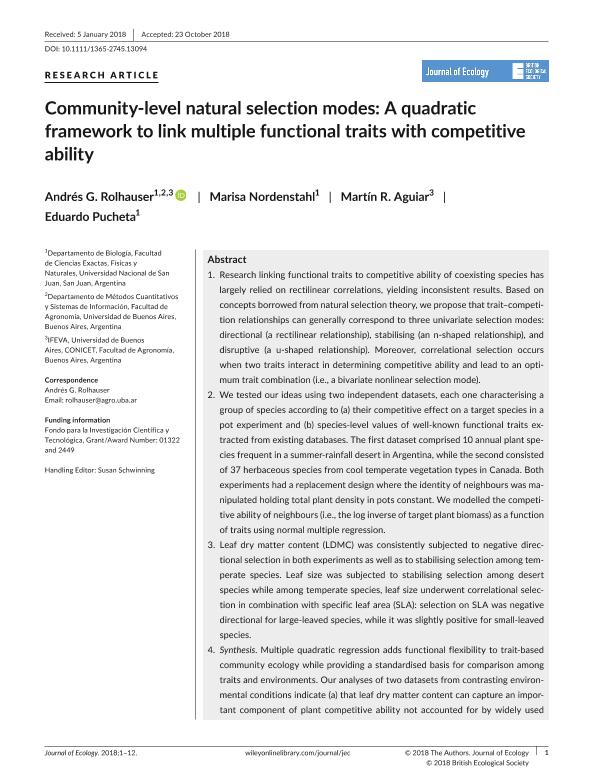Artículo
Community-level natural selection modes: A quadratic framework to link multiple functional traits with competitive ability
Fecha de publicación:
05/11/2018
Editorial:
Wiley Blackwell Publishing, Inc
Revista:
Journal of Ecology
ISSN:
0022-0477
Idioma:
Inglés
Tipo de recurso:
Artículo publicado
Clasificación temática:
Resumen
Research linking functional traits to competitive ability of coexisting species has largely relied on rectilinear correlations, yielding inconsistent results. Based on concepts borrowed from natural selection theory, we propose that trait?competition relationships can generally correspond to three univariate selection modes: directional (a rectilinear relationship), stabilising (an n-shaped relationship), and disruptive (a u-shaped relationship). Moreover, correlational selection occurs when two traits interact in determining competitive ability and lead to an optimum trait combination (i.e., a bivariate nonlinear selection mode). We tested our ideas using two independent datasets, each one characterising a group of species according to (a) their competitive effect on a target species in a pot experiment and (b) species-level values of well-known functional traits extracted from existing databases. The first dataset comprised 10 annual plant species frequent in a summer-rainfall desert in Argentina, while the second consisted of 37 herbaceous species from cool temperate vegetation types in Canada. Both experiments had a replacement design where the identity of neighbours was manipulated holding total plant density in pots constant. We modelled the competitive ability of neighbours (i.e., the log inverse of target plant biomass) as a function of traits using normal multiple regression. Leaf dry matter content (LDMC) was consistently subjected to negative directional selection in both experiments as well as to stabilising selection among temperate species. Leaf size was subjected to stabilising selection among desert species while among temperate species, leaf size underwent correlational selection in combination with specific leaf area (SLA): selection on SLA was negative directional for large-leaved species, while it was slightly positive for small-leaved species. Synthesis. Multiple quadratic regression adds functional flexibility to trait-based community ecology while providing a standardised basis for comparison among traits and environments. Our analyses of two datasets from contrasting environmental conditions indicate (a) that leaf dry matter content can capture an important component of plant competitive ability not accounted for by widely used competitive traits, such as specific leaf area, leaf size, and plant height and (b) that optimum relationships (either univariate or bivariate) between competitive ability and plant traits may be more common than previously realised.
Archivos asociados
Licencia
Identificadores
Colecciones
Articulos(IFEVA)
Articulos de INST.D/INV.FISIOLOGICAS Y ECO.VINCULADAS A L/AGRIC
Articulos de INST.D/INV.FISIOLOGICAS Y ECO.VINCULADAS A L/AGRIC
Citación
Rolhauser, Andrés Guillermo; Nordenstahl, Marisa; Aguiar, Martin Roberto; Pucheta, Eduardo Raúl; Community-level natural selection modes: A quadratic framework to link multiple functional traits with competitive ability; Wiley Blackwell Publishing, Inc; Journal of Ecology; 107; 3; 5-11-2018; 1457-1468
Compartir
Altmétricas




